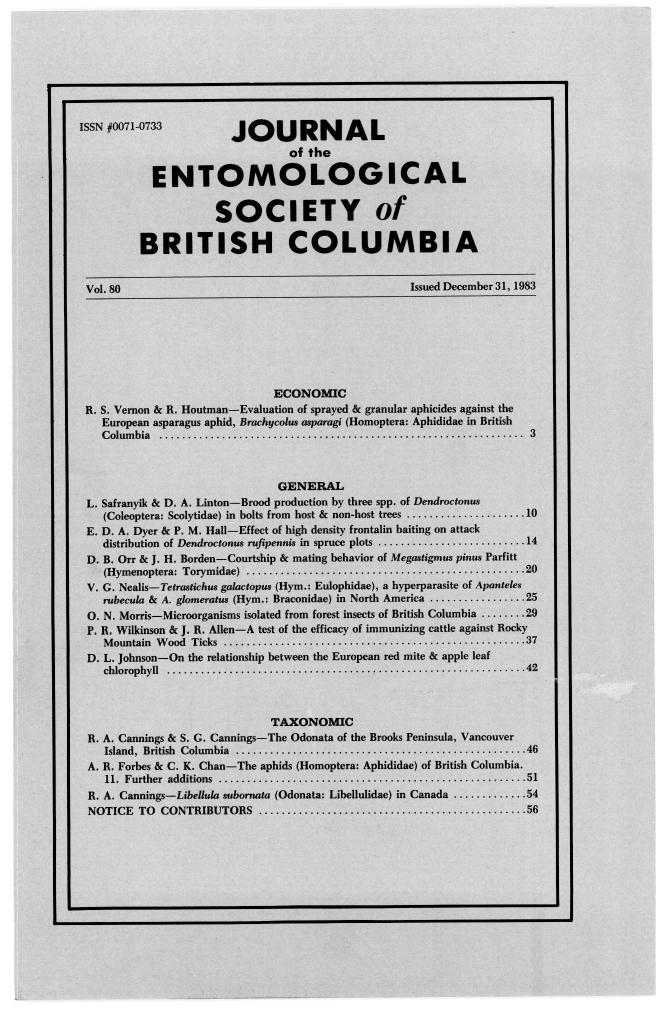Microorganisms isolated from forest insects of British Columbia
Abstract
Pathogenic and non-pathogenic microorganisms including fungi, bacteria, viruses, miscrosporidia and nematodes were isolated from about 14,000 specimens representing 108 pest species of insects collected from British Columbia forests between 1949 and 1969. <i>Entomophthora</i> sp. and <i>Beauveria</i> sp were the most widely distributed fungal organisms isolated, occurring in 14 and 29 insect species, respectively. Nuclear polvhedrosis and granulosis viruses were isolated from 53 species, microsporida from 26, pathogenic bacteria from 12 and nematodes from 2 species. A new variety of <i>Bacillus thuringiensis</i>, viz. <i>canadensis</i>, was isolated from <i>Lambdina fiscellaria lugubrosa</i> (Hlst.) and a <i>Neophasia</i> sp. The largest numbers of species of microorganisms were found in <i>Melanolophia imitata</i> (Wlk.), <i>Malacosoma disstria</i> Hbn., <i>M. pluviale</i> (Dyar), <i>L. f. lugubrosa</i>, <i>Acleris variana</i> (Fern.), <i>Hyphantria cunea</i> Dru., <i>Choristoneura fumiferana</i> (Clem), <i>Orgyia pseudotsugata</i> (McD) and <i>Neophasia menapia</i> Feld.References
de Barjac, H. and Bonnefoi, A. 1972. Presence of H antigenic subfactors in Serotype V of Bacillus thuringiensis with the description of a new type: B. thuringiensis var. canadensis. J. Invertebr. Pathol. 20: 212-213.
Burke, J.M. 1980. A survey of microorganisms infecting a spruce budworm population. Can. For. Serv. Rept. PFM-X-37. 9 pp.
Finney, J.R. 1981. Potential of nematodes for pest control. In Microbial Control of Pest and Plant Disease H.D. Burges (Ed.). Academic Press, N.Y. pp. 603-620.
MacLeod, D.M. 1954. Investigations on the genus Beauveria Vuill. and Tritirachium Limber. Can. J. Bot. 32:818-890.
MacLeod, D.M. 1956. Notes on the genus Empusa Cohn. Can. J. Bot. 34:16-26.
MacLeod, D.M. and E. Muller-Kogler. 1973. Entomogenous fungi: Entomophthora species with pear-shaped to almost spherical conidia (Entomophthorales: Entomophthoracease). Mycologia 65:823-893.
Morris, O.N. 1962a. Studies on the causative agent and histopathology of a virus disease of the western oak looper. J. Insect Pathol. 4:446-453.
Morris, O.N. 1962b. Quantitative infectivity studies on the nuclear polyhedrosis virus of the western oak looper, Lambdina fiscellaria somniaiia (Hlst.). J. Insect Pathol. 4:207-215.
Morris, O.N. 1963a. The natural and artificial control of the Douglas-fir tussock moth, Orgyia pseudotsugata McDunnough, by a nuclear polyhedrosis virus. J. Insect. Pathol. 4:401-414.
Morris, O. N. 1963b. A nuclear polyhedrosis of Orgyia pseudotsugata: causative-agent and histopathology. Can. J. Microbiol. 9:899-900.
Morris, O.N. 1967. A virus disease of Ectropis crepuscularia Schiff. (Lepidoptera: Geometridae). Can. J. Microbiol. 13:855-858.
Morris, O.N. and P. Olsen. 1970. Insect disease survey in British Columbia, 1964-1969. Can. For. Serv. Rept. BC-X-47. 15 pp.
Samson, R.A. 1981. Identification: Entomopathogenic Deuteromycetes. Pp. 93-106. In “Microbial Control of Pests and Diseases” H. D. Burges (Ed.). Academic Press, N.Y.
Smirnoff, W.A. and A. Junean. 1973. Quinze annees de recherches sur les microorganismes des insectes forestieres de la Province de Quebec (1957-1972). Ann. Soc. Ent. Quebec 18:147-181.
Thomson, H.M. 1960. A list and brief description of the Microsporidia infecting insects. J. Insect Pathol. 2:346-385.
Wilson, G.G. 1975. Occurrence of Thelohania sp. and Pleistophora sp. (Microsporidia: Nosematidae) in Choristoneura fumiferana (Lepidoptera: Tortricidae). Can. J. Zool. 53:1799-1802.
Wilson, G.G. and J.M. Burke. 1971. Nosema thomsoni n. sp., a microsporidian from Choristoneura conflictana (Lepidoptera: Tortricidae). Can. J. Zool. 49:786-788.
Downloads
Published
Issue
Section
License
Authors who publish with the Journal of the Entomological Society of British Columbia agree to the following terms:
-Authors retain copyright and grant the journal right of first publication with the work simultaneously licensed under a Creative Commons Attribution License that allows others to share the work with an acknowledgement of the work's authorship and initial publication in this journal.
-Authors are able to enter into separate, additional contractual arrangements for the non-exclusive distribution of the journal's published version of the work (e.g., post it to an institutional repository or publish it in a book), with an acknowledgement of its initial publication in this journal.
-Authors are permitted and encouraged to post their work online (e.g., in institutional repositories or on their website) prior to and during the submission process, as it can lead to productive exchanges, as well as earlier and greater citation of published work (See The Effect of Open Access).


